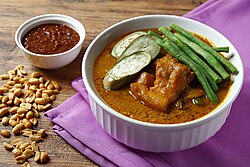Kare-kare
 A bowl of kare-kare | |
| Course | Main course |
|---|---|
| Place of origin | Philippines |
| Serving temperature | Hot |
| Main ingredients | Oxtail, peanut sauce, vegetables |
| Variations | Goat meat kare-kare |
Kare-kare is a
Condiments and other flavorings are usually added. It is often eaten with
Traditionally, most Filipino fiestas have kare-kare.[3]
A more modern twist to the classic Filipino kare-kare uses a different dish as the main meat for this dish. Pork is one of the most economical and easiest meats to cook. The most common meats repurposed for kare-kare are lechon (which is also used for lechon kawali)[4] and crispy pata (crispy pork shank). Alternative main proteins are tofu, beef chuck, beef shank, and maskara ng baka or cartilage from the cow's face, and tripe.[5]
History
Kare-kare's history as a Filipino food goes back centuries. There are four stories as to the origins of kare-kare. The first one is that it came from
Preparation

The
Kare-kare is often served hot with special bagoong alamang (sauteed salted shrimp paste).[citation needed]
See also
- Adobo
- Afritada
- Balbacua
- Dinuguan
- Escabeche
- Kaldereta
- Mechado
- Menudo (stew)
- Sarsiado
- Tinola
- List of peanut dishes
- List of Philippine dishes
- List of stews
References
- ^ "Kare-Kare: Filipino ox tail stew".
- ^ "Kare-Kare Recipe".
- ^ "Philippines: Kare Kare". 196 flavors. January 7, 2019. Retrieved March 5, 2020.
- ^ Santos, Rachelle (June 9, 2011). "Lechon Kawali Kare-Kare". yummy.ph. Retrieved August 1, 2021.
- ^ "Kare Kare Recipe". Panlasang Pinoy. Retrieved November 7, 2021.
- ^ "Philippines: Kare Kare". 196 flavors. January 7, 2019. Retrieved March 5, 2020.
- ^ Hernandez, Kathrine Pearl. "Brief History of Kare-kare – Executive Gourmet Catering Services". Retrieved March 5, 2020.
- ^ Villar, Roberto (August 2, 2019). "The Fascinating History of Kare-kare". Esquiremag.ph. Retrieved March 5, 2020.
External links
 Media related to Kare-kare at Wikimedia Commons
Media related to Kare-kare at Wikimedia Commons

